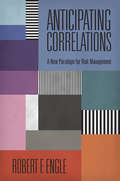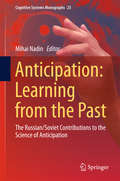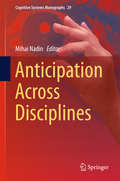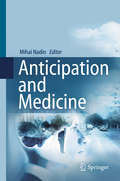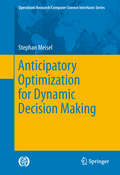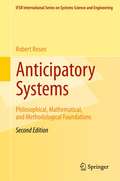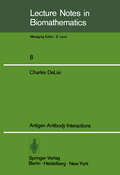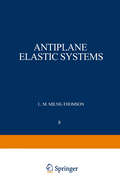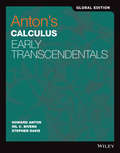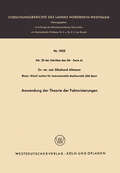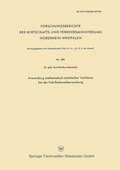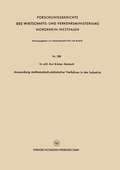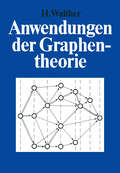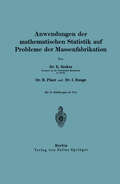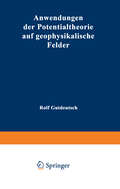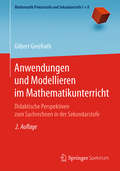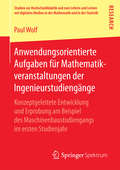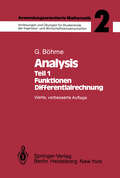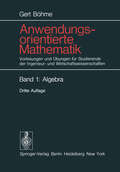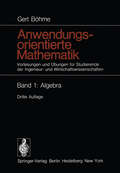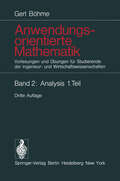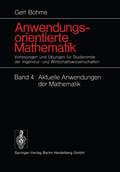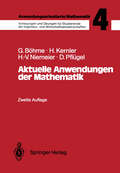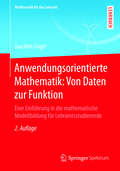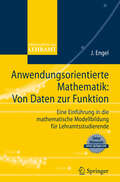- Table View
- List View
Anticipating Correlations: A New Paradigm for Risk Management (PDF)
by Robert EngleFinancial markets respond to information virtually instantaneously. Each new piece of information influences the prices of assets and their correlations with each other, and as the system rapidly changes, so too do correlation forecasts. This fast-evolving environment presents econometricians with the challenge of forecasting dynamic correlations, which are essential inputs to risk measurement, portfolio allocation, derivative pricing, and many other critical financial activities. In Anticipating Correlations, Nobel Prize-winning economist Robert Engle introduces an important new method for estimating correlations for large systems of assets: Dynamic Conditional Correlation (DCC). Engle demonstrates the role of correlations in financial decision making, and addresses the economic underpinnings and theoretical properties of correlations and their relation to other measures of dependence. He compares DCC with other correlation estimators such as historical correlation, exponential smoothing, and multivariate GARCH, and he presents a range of important applications of DCC. Engle presents the asymmetric model and illustrates it using a multicountry equity and bond return model. He introduces the new FACTOR DCC model that blends factor models with the DCC to produce a model with the best features of both, and illustrates it using an array of U.S. large-cap equities. Engle shows how overinvestment in collateralized debt obligations, or CDOs, lies at the heart of the subprime mortgage crisis--and how the correlation models in this book could have foreseen the risks. A technical chapter of econometric results also is included. Based on the Econometric and Tinbergen Institutes Lectures, Anticipating Correlations puts powerful new forecasting tools into the hands of researchers, financial analysts, risk managers, derivative quants, and graduate students.
Anticipation: The Russian/Soviet Contributions to the Science of Anticipation (Cognitive Systems Monographs #25)
by Mihai NadinThis volume presents the work of leading scientists from Russia, Georgia, Estonia, Lithuania, Israel and the USA, revealing major insights long unknown to the scientific community. Without any doubt their work will provide a springboard for further research in anticipation. Until recently, Robert Rosen (Anticipatory Systems) and Mihai Nadin (MIND – Anticipation and Chaos) were deemed forerunners in this still new knowledge domain.The distinguished neurobiologist, Steven Rose, pointed to the fact that Soviet neuropsychological theories have not on the whole been well received by Western science. These earlier insights as presented in this volume make an important contribution to the foundation of the science of anticipation. It is shown that the daring hypotheses and rich experimental evidence produced by Bernstein, Beritashvili, Ukhtomsky, Anokhin and Uznadze, among others—extend foundational work to aspects of neuroscience, physiology, motorics, education.
Anticipation Across Disciplines (Cognitive Systems Monographs #29)
by Mihai NadinNever before was anticipation more relevant to the life and activity of humankind than it is today. “It is no overstatement to suggest that humanity’s future will be shaped by its capacity to anticipate….” (Research Agenda for the 21st Century, National Science Foundation). The sciences and the humanities can no longer risk explaining away the complexity and interactivity that lie at the foundation of life and living. The perspective of the world that anticipation opens justifies the descriptor “the post-Cartesian Revolution.”If anticipation is a valid research domain, what practical relevance can we await? Indeed, anticipation is more than just the latest catch-word in marketing the apps developed by the digital technology industry. Due to spectacular advances in the study of the living, anticipation can claim a legitimate place in current investigations and applications in the sciences and the humanities. Biology, genetics, medicine, as well as politics and cognitive, behavioral, and social sciences, provide rich evidence of anticipatory processes at work. Readers seeking a foundation for anticipation will find in these pages recent outcomes pertinent to plant life, political anticipation, cognitive science, architecture, computation. The authors contributing to this volume frame experimental data in language that can be shared among experts from all fields of endeavor. The major characteristic is the inference from the richness of data to principles and practical consequences.
Anticipation and Medicine
by Mihai NadinIn this book, practicing physicians and experts in anticipation present arguments for a new understanding of medicine. Their contributions make it clear that medicine is the decisive test for anticipation. The reader is presented with a provocative hypothesis: If medicine will align itself with the anticipatory condition of life, it can prompt the most important revolution in our time. To this end, all stakeholders—medical practitioners, patients, scientists, and technology developers—will have to engage in the conversation. The book makes the case for the transition from expensive, and only marginally effective, reactive treatment through “spare parts” (joint replacements, organ transplants) and reliance on pharmaceuticals (antibiotics, opiates) to anticipation-informed healthcare. Readers will understand why the current premise of treating various behavioral conditions (attention deficit disorder, hyperactivity, schizophrenia) through drugs has to be re-evaluated from the perspective of anticipation. In the manner practiced today, medicine generates dependence and long-lasting damage to those it is paid to help. As we better understand the nature of the living, the proactive view of healthcare, within which the science and art of healing fuse, becomes a social and political mandate.
Anticipatory Optimization for Dynamic Decision Making (Operations Research/Computer Science Interfaces Series #51)
by Stephan MeiselThe availability of today’s online information systems rapidly increases the relevance of dynamic decision making within a large number of operational contexts. Whenever a sequence of interdependent decisions occurs, making a single decision raises the need for anticipation of its future impact on the entire decision process. Anticipatory support is needed for a broad variety of dynamic and stochastic decision problems from different operational contexts such as finance, energy management, manufacturing and transportation. Example problems include asset allocation, feed-in of electricity produced by wind power as well as scheduling and routing. All these problems entail a sequence of decisions contributing to an overall goal and taking place in the course of a certain period of time. Each of the decisions is derived by solution of an optimization problem. As a consequence a stochastic and dynamic decision problem resolves into a series of optimization problems to be formulated and solved by anticipation of the remaining decision process.However, actually solving a dynamic decision problem by means of approximate dynamic programming still is a major scientific challenge. Most of the work done so far is devoted to problems allowing for formulation of the underlying optimization problems as linear programs. Problem domains like scheduling and routing, where linear programming typically does not produce a significant benefit for problem solving, have not been considered so far. Therefore, the industry demand for dynamic scheduling and routing is still predominantly satisfied by purely heuristic approaches to anticipatory decision making. Although this may work well for certain dynamic decision problems, these approaches lack transferability of findings to other, related problems.This book has serves two major purposes:‐ It provides a comprehensive and unique view of anticipatory optimization for dynamic decision making. It fully integrates Markov decision processes, dynamic programming, data mining and optimization and introduces a new perspective on approximate dynamic programming. Moreover, the book identifies different degrees of anticipation, enabling an assessment of specific approaches to dynamic decision making.‐ It shows for the first time how to successfully solve a dynamic vehicle routing problem by approximate dynamic programming. It elaborates on every building block required for this kind of approach to dynamic vehicle routing. Thereby the book has a pioneering character and is intended to provide a footing for the dynamic vehicle routing community.
Anticipatory Systems: Philosophical, Mathematical, and Methodological Foundations (IFSR International Series in Systems Science and Systems Engineering #1)
by Robert RosenRobert Rosen was not only a biologist, he was also a brilliant mathematician whose extraordinary contributions to theoretical biology were tremendous. Founding, with this book, the area of Anticipatory Systems Theory is a remarkable outcome of his work in theoretical biology. This second edition of his book Anticipatory Systems, has been carefully revised and edited, and includes an Introduction by Judith Rosen. It has also been expanded with a set of Prolegomena by Dr. Mihai Nadin, who offers an historical survey of this fast growing field since the original work was published. There is also some exciting new work, in the form of an additional chapter on the Ontology of Anticipation, by Dr. John Kineman. An addendum-- with autobiographical reminiscences by Robert Rosen, himself, and a short story by Judith Rosen about her father-- adds a personal touch. This work, now available again, serves as the guiding foundations for the growing field of Anticipatory Systems and, indeed, any area of science that deals with living organisms in some way, including the study of Life and Mind. It will also be of interest to graduate students and researchers in the field of Systems Science.
Antigen Antibody Interactions (Lecture Notes in Biomathematics #8)
by C. Delisi1. 1 Organization of the Immune System One of the most important survival mechanisms of vertebrates is their ability to recognize and respond to the onslaught of pathogenic microbes to which they are conti- ously exposed. The collection of host cells and molecules involved in this recognition 12 response function constitutes its immune system. In man, it comprises about 10 cells 20 (lymphocytes) and 10 molecules (immunoglobulins). Its ontogenic development is c- strained by the requirement that it be capable of responding to an almost limitless variety of molecular configurations on foreign substances, while simultaneously remaining inert to those on self components. It has thus evolved to discriminate, with exquisite precision, between molecular patterns. The foreign substances which induce a response, called antigens, are typically large molecules such as proteins and polysaccharides. The portions of these with which immunoglobulins interact are called epitopes or determinants. A typical protein epitope may consist of a configuration formed by the spatial arrangements of four or five amino acids and have an average linear dimension of about 20 A.
Antiplane Elastic Systems (Ergebnisse der angewandten Mathematik #8)
by Louis M. Milne-ThomsonThe term antiplane was introduced by L. N. G. FlLON to describe such problems as tension, push, bending by couples, torsion, and flexure by a transverse load. Looked at physically these problems differ from those of plane elasticity already treated * in that certain shearing stresses no longer vanish. This book is concerned with antiplane elastic systems in equilibrium or in steady motion within the framework of the linear theory, and is based upon lectures given at the Royal Naval College, Greenwich, to officers of the Royal Corps of Naval Constructors, and on technical reports recently published at the Mathematics Research Center, United States Army. My aim has been to tackle each problem, as far as possible, by direct rather than inverse or guessing methods. Here the complex variable again assumes an important role by simplifying equations and by introducing order into much of the treatment of anisotropic material. The work begins with an introduction to tensors by an intrinsic method which starts from a new and simple definition. This enables elastic properties to be stated with conciseness and physical clarity. This course in no way commits the reader to the exclusive use of tensor calculus, for the structure so built up merges into a more familiar form. Nevertheless it is believed that the tensor methods outlined here will prove useful also in other branches of applied mathematics.
Anton's Calculus Early Transcendentals
by Howard Anton Irl C. Bivens Stephen DavisAnton's Calculus, Early Transcendentals strives to increase student comprehension and conceptual understanding through a balance between rigor and clarity of explanations, sound mathematics, and excellent exercises, applications, and examples. Anton pedagogically approaches Calculus through the Rule of Four, presenting concepts from the verbal, algebraic, visual, and numerical points of view.
Anwendung der Theorie der Faktorisierungen (Forschungsberichte des Landes Nordrhein-Westfalen #1902)
by Ekkehard AltmannAnwendung mathematisch-statistischer Verfahren bei der Fabrikationsüberwachung (Forschungsberichte des Wirtschafts- und Verkehrsministeriums Nordrhein-Westfalen #480)
by Kurt Brücker-SteinkuhlAnwendung mathematisch-statistischer Verfahren in der Industrie (Forschungsberichte des Wirtschafts- und Verkehrsministeriums Nordrhein-Westfalen #480)
by Kurt Brücker-SteinkuhlMathematisch-statistische Untersuchungen in der Technik stellen keine Sammlung von Daten oder Erkenntnissen dar, die neben den technischen Pro zessen einhergeht; sie sind vielmehr Vorgänge, die mehr oder weniger tief, mittelbar und unmittelbar in das Fabrikationsgeschehen eingreifen. Erstes Kriterium für die Anwendbarkeit mathematisch-statistischer Methoden ist der nachweisbare praktische und wirtschaftliche Erfolg. Tritt ein sol cher Erfolg nicht ein, so sind die Methoden überflüssig und ihre Anwen dung erübrigt sich. Wenn gefragt wird, warum die Anwendung statistischer Verfahren gerade oder erst jetzt vorangetrieben wird, so ist zu sagen, daß die Genauigkeitsan sprüche ein derartiges Maß erreicht haben, daß die natürlichen und nicht zu unterdrückenden Streuungen technischer Prozesse eine immer größere Be achtung verlangen. Die Technik befindet sich vergleichsweise nunmehr in einer Situation, die für die Biologie und Landwirtschaft bereits seit einigen Jahrzehnten kennzeichnend ist, weil die natürlichen Streuungen der organischen Vorgänge relativ größer sind und noch zeitiger zu . einer Berücksichtigung zwangen als die Streuungen der technischen Vorgänge. Die Schonfrist der kleineren technischen Streuungen ist indessen abgelaufen, und auch im Fabrikationsgeschehen sind die Zeiten der reinen Empirie un widerruflich vorbei. Was nun erforderlich ist und was zu den nachhaltig sten Wirkungen führen wird, ist eine Verbindung von Praxis und subtiler Theorie, wie sie durch die Anwendung mathematisch-statistischer Methoden in der Technik gegeben ist. Die vorliegenden Beiträge behandeln einige Untersuchungen auf diesem noch weitgehend unbearbeiteten Anwendungsfeld.
Anwendungen der mathematischen Statistik auf Probleme der Massenfabrikation
by Richard Becker H. Plaut I. RungeDieser Buchtitel ist Teil des Digitalisierungsprojekts Springer Book Archives mit Publikationen, die seit den Anfängen des Verlags von 1842 erschienen sind. Der Verlag stellt mit diesem Archiv Quellen für die historische wie auch die disziplingeschichtliche Forschung zur Verfügung, die jeweils im historischen Kontext betrachtet werden müssen. Dieser Titel erschien in der Zeit vor 1945 und wird daher in seiner zeittypischen politisch-ideologischen Ausrichtung vom Verlag nicht beworben.
Anwendungen und Modellieren im Mathematikunterricht: Didaktische Perspektiven zum Sachrechnen in der Sekundarstufe (Mathematik Primarstufe und Sekundarstufe I + II)
by Gilbert GreefrathDie in diesem Buch dargestellten Anwendungen prägen den aktuellen Mathematikunterricht der Sekundarstufe. Didaktische Perspektiven zum Sachrechnen und das mathematische Modellieren sind eine wichtige Grundlage für die Lehrerbildung. Auch die aktuellen Bildungsstandards stellen prozessbezogene Kompetenzen wie das Modellieren in den Vordergrund. In diesem Lehrbuch lernen Sie aktuelle Sichtweisen auf Anwendungen im Mathematikunterricht vor dem Hintergrund des Sachrechnens und des mathematischen Modellierens kennen. Besonders ausführlich werden die vielfältigen Aufgabentypen eines anwendungsorientierten Mathematikunterrichts dargestellt und klassifiziert. Hier erhalten Sie auch viele Anregungen für den Unterricht. Einige typische Unterrichtsinhalte zu Anwendungen in der Sekundarstufe wie Zuordnungen von Größen und der Einsatz digitaler Werkzeuge runden den Band ab. Das Buch wendet sich an Lehramtsstudierende, Referendarinnen und Referendare sowie Lehrkräfte mit Mathematik als Fach.
Anwendungsorientierte Aufgaben für Mathematikveranstaltungen der Ingenieurstudiengänge: Konzeptgeleitete Entwicklung und Erprobung am Beispiel des Maschinenbaustudiengangs im ersten Studienjahr (Studien zur Hochschuldidaktik und zum Lehren und Lernen mit digitalen Medien in der Mathematik und in der Statistik)
by Paul WolfPaul Wolf entwickelt und erprobt einen neuen Typ von Anwendungsaufgaben für die Service-Veranstaltungen der Mathematik mit Fokus auf die Verbindung von Mathematik und dem eigentlichen Studienfach. Motiviert wurde die Arbeit durch die relativ hohe Abbruchquote in den Ingenieurs-Bachelor-Studiengängen, die unter anderem auf die Komplexität und Relevanz der Mathematikausbildung während des Studiums zurückzuführen ist. Trotz des speziellen Bezugs zum Maschinenbau lässt sich das Konzept auch auf andere Studiengänge (z.B. Elektrotechnik) übertragen. Der Autor evaluiert sein Konzept durch eine vollständige empirische Vergleichsstudie in mehreren Jahrgängen.
Anwendungsorientierte Mathematik: Band 2: Analysis I: Funktionen, Differentialrechnung (Springer-Lehrbuch #2)
by Gert BöhmeAnwendungsorientierte Mathematik: Vorlesungen und Übungen für Studierende der Ingenieur- und Wirtschaftswissenschaften
by Gert BöhmeAnwendungsorientierte Mathematik: Vorlesungen und Übungen für Studierende der Ingenieur- und Wirtschaftswissenschaften Band 1: Algebra
by Gert BöhmeAnwendungsorientierte Mathematik: Vorlesungen und Übungen für Studierende der Ingenieur- und Wirtschaftswissenschaften
by Gert BöhmeAnwendungsorientierte Mathematik: Vorlesungen und Übungen für Studierende der Ingenieur- und Wirtschaftswissenschaften Aktuelle Anwendungen der Mathematik
by Gert Böhme H. Kernler H.-V. Niemeier D. PflügelAnwendungsorientierte Mathematik: Band 4: Aktuelle Anwendungen der Mathematik
by Gert Böhme Helmut Kernler Hans-Volker Niemeier Dieter PflügelDieser Band rundet das dreibändige Lehrbuch ab, das aus Vorlesungen an der Fachhochschule Furtwangen/Schwarzwald hervorgegangen ist. Es enthält eine Auswahl mathematischer Anwendungen, die in den letzten Jahren - auch für die Praxis - immer mehr an Bedeutung gewonnen haben: Prognoseverfahren, Wortstrukturen, Automaten, Graphen und Bestandsoptimierung. Die einzelnen Kapitel können unabhängig voneinander gelesen werden. Sie bieten einen ersten, leicht lesbaren und auf die Bedürfnisse der Praxis zugeschnittenen Einstieg. Das Buch wendet sich daher nicht nur an Studenten, sondern auch an Interessierte im Berufsleben.
Anwendungsorientierte Mathematik: Eine Einführung in die mathematische Modellbildung für Lehramtsstudierende (Mathematik für das Lehramt)
by Joachim EngelGegenstand des vorliegenden Lehrbuches ist der Prozess des Anwendens von Mathematik. Im Mittelpunkt stehen dabei der Funktionsbegriff sowie mathematische Methoden zur Modellierung funktionaler Abhängigkeiten zwischen zwei Größen.Das Buch zeichnet sich durch folgende besondere Merkmale aus:Reale Daten als Grundlage für viele Modellierungen als eine wichtige Voraussetzung für einen authentischen und glaubwürdigen Unterricht an Hochschule und Schule.Einsatz von Technologie als Werkzeug zum Problemlösen und zur Illustrierung von Konzepten und Zusammenhängen.Vernetzung verschiedener Inhalte der Mathematik wie Elementare Funktionenlehre, Analysis, Stochastik, Lineare Algebra,Numerik.Detaillierte Ableitungen von Ergebnissen sowie Übungen und Fragen am Ende der einzelnen Kapitel mit teilweise ausgearbeiteten Lösungen und mit Lösungshinweisen helfen bei der Vertiefung des Stoffes.
Anwendungsorientierte Mathematik: Eine Einführung in die mathematische Modellbildung für Lehramtsstudierende (Mathematik für das Lehramt)
by Joachim EngelGegenstand des Lehrbuchs ist der Prozess des Anwendens von Mathematik. Im Mittelpunkt stehen der Funktionsbegriff sowie mathematische Methoden zur Modellierung funktionaler Abhängigkeiten zwischen zwei Größen. Das Buch zeichnet sich u. a. dadurch aus, dass reale Daten als Basis für viele Modellierungen dienen und dass verschiedene Gebiete der Mathematik wie etwa die Funktionenlehre und Analysis miteinander vernetzt werden. Detaillierte Ableitungen von Ergebnissen sowie Übungen und Fragen am Ende jedes Kapitels helfen bei der Vertiefung des Stoffs.
